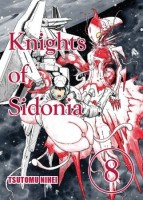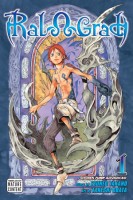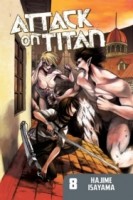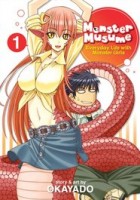My News and Reviews
Happy New Year, everyone! Things are already off to a good start at Experiments in Manga. The last manga giveaway of 2014 is currently underway and there’s still time to enter for a chance to win No Matter How I Look at It, It’s You Guys’ Fault I’m Not Popular!, Volume 1 by Nico Tanigawa. All you have to do is tell me a little about some of your favorite otaku. The honor of the first in-depth manga review of the year, and in fact the very first post of 2015, goes to Hiroaki Samura’s Vigilance, the thirtieth and penultimate volume of Blade of the Immortal. I still love the series after all this time, and this installment has some particularly nice fight sequences. Finally, December’s Bookshelf Overload was posted over the weekend as well.
There were a few interesting things from Vertical this week, including a roundup of the happenings of 2014 and what fans can look forward to from the publisher in 2015. Another enlightening read from Vertical’s Tumblr account tackles sports, sports fiction, and sports manga and the challenges it presents to the North American market. Also, in case you missed it, Vertical is now on ask.fm and is answering all sorts of questions there. Last but not least, thanks to the success of its release of Mobile Suit Gundam: The Origin, Vertical is looking into publishing more Gundam manga. If you’re interested and haven’t already, be sure to take Vertical’s Gundam survey which will be open through the end of today.
Elsewhere online, Khursten has made a manga resolution for the year to feature josei more at Otaku Champloo. Organization Anti-Social Geniuses debuted a new feature, Inside the Industry, with Inside the Manga Industry with Lillian Diaz-Przybyl. The Hairpin has an excellent interview with Anne Ishii who, among other things, is the translator and one of the editors of the newly released Massive: Gay Erotic Manga and the Men Who Make It (which I recently reviewed; it’s great).
Quick Takes
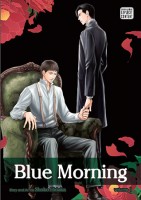 Blue Morning, Volumes 1-5 by Shoko Hidaka. I’ve been meaning to read Blue Morning for a while but have only now gotten around to it. The benefit of this is that I had five volumes that I could read all at once. The drawback, of course, is the long wait until the sixth volume is released. I loved Blue Morning. It’s a moody, slow-burning boys’ love series with beautiful, elegant artwork and well-developed, subtly nuanced characters. A dramatic period piece, the manga takes place during Japan’s Meji era in which the country’s social, political, and economic structures underwent great change. The story focuses on Akihito Kuze who, after being orphaned, is suddenly thrust into Japan’s peerage as a viscount at the age of ten. Tomoyuki Katsuragi, the Kuze family steward, becomes his tutor and guardian. As he grows Akihito ends up developing feelings for Katsuragi and their relationship undergoes an intense evolution and power reversal. The romantic elements of Blue Morning are important, but much of the plot is actually focused on the political maneuverings of both Katsuragi and Akihito to raise the family’s status, though the each of the men have their own reasons for doing so.
Blue Morning, Volumes 1-5 by Shoko Hidaka. I’ve been meaning to read Blue Morning for a while but have only now gotten around to it. The benefit of this is that I had five volumes that I could read all at once. The drawback, of course, is the long wait until the sixth volume is released. I loved Blue Morning. It’s a moody, slow-burning boys’ love series with beautiful, elegant artwork and well-developed, subtly nuanced characters. A dramatic period piece, the manga takes place during Japan’s Meji era in which the country’s social, political, and economic structures underwent great change. The story focuses on Akihito Kuze who, after being orphaned, is suddenly thrust into Japan’s peerage as a viscount at the age of ten. Tomoyuki Katsuragi, the Kuze family steward, becomes his tutor and guardian. As he grows Akihito ends up developing feelings for Katsuragi and their relationship undergoes an intense evolution and power reversal. The romantic elements of Blue Morning are important, but much of the plot is actually focused on the political maneuverings of both Katsuragi and Akihito to raise the family’s status, though the each of the men have their own reasons for doing so.
 Knights of Sidonia, Volumes 10-12 by Tsutomu Nihei. I decided to save up a few volumes of Knights of Sidonia since they read so quickly and I wanted to enjoy a larger chunk of the story. But even though there are quite a few major developments in these particular volumes, including the introduction of an important new character, somehow it just feels like Nihei is stalling for time and that there wasn’t actually much forward movement in the series. Even so, it was still an enjoyable read and I still like the manga. Knights of Sidionia remains a rather peculiar series, a combination of horror, science fiction and, of all things, romantic comedy. Sidonia’s hero Tanikaze, despite being incredibly awkward socially, has managed capture the romantic interest of quite a few of the other characters, basically amassing one of the most unusual harems that I’ve ever come across in manga. And while he has all sorts of domestic challenges to deal with now that his house has five residents more or less living there, he’s also one of humanity’s best pilots in the fight for survival against the Gauna. The war is entering a new stage, new technology has been developed, and the Gauna continue to gain new abilities.
Knights of Sidonia, Volumes 10-12 by Tsutomu Nihei. I decided to save up a few volumes of Knights of Sidonia since they read so quickly and I wanted to enjoy a larger chunk of the story. But even though there are quite a few major developments in these particular volumes, including the introduction of an important new character, somehow it just feels like Nihei is stalling for time and that there wasn’t actually much forward movement in the series. Even so, it was still an enjoyable read and I still like the manga. Knights of Sidionia remains a rather peculiar series, a combination of horror, science fiction and, of all things, romantic comedy. Sidonia’s hero Tanikaze, despite being incredibly awkward socially, has managed capture the romantic interest of quite a few of the other characters, basically amassing one of the most unusual harems that I’ve ever come across in manga. And while he has all sorts of domestic challenges to deal with now that his house has five residents more or less living there, he’s also one of humanity’s best pilots in the fight for survival against the Gauna. The war is entering a new stage, new technology has been developed, and the Gauna continue to gain new abilities.
 Say I Love You, Volume 4 by Kanae Hazuki. Four volumes in, Say I Love You continues to set itself apart from many of the other shoujo manga series that are currently being released with its very realistic approach to young adult relationships, romance, and sexuality. The characters show a believable mix of maturity and immaturity, at times handling themselves extraordinarily well and at other times ending up a mess of confused emotions. This volume also introduces a new character, Kai, whom I’m particularly looking forward to seeing more of. In the afterword Hazuki mentions that she believes that manga “isn’t just for showing the nice side of things,” a belief that I think comes through in Say I Love You. There are the wonderful moments between characters as they grow closer, but every relationship has its ups and downs and Hazuki isn’t afraid to show the emotional pain and turmoil experienced by her characters as part of that growth. Regret, jealousy, selfishness, and uncertainty all have a role to play as do happiness, affection, altruism, and confidence. None of the characters are perfect and they all make mistakes as they navigate new and sometimes surprising relationships.
Say I Love You, Volume 4 by Kanae Hazuki. Four volumes in, Say I Love You continues to set itself apart from many of the other shoujo manga series that are currently being released with its very realistic approach to young adult relationships, romance, and sexuality. The characters show a believable mix of maturity and immaturity, at times handling themselves extraordinarily well and at other times ending up a mess of confused emotions. This volume also introduces a new character, Kai, whom I’m particularly looking forward to seeing more of. In the afterword Hazuki mentions that she believes that manga “isn’t just for showing the nice side of things,” a belief that I think comes through in Say I Love You. There are the wonderful moments between characters as they grow closer, but every relationship has its ups and downs and Hazuki isn’t afraid to show the emotional pain and turmoil experienced by her characters as part of that growth. Regret, jealousy, selfishness, and uncertainty all have a role to play as do happiness, affection, altruism, and confidence. None of the characters are perfect and they all make mistakes as they navigate new and sometimes surprising relationships.
 Ping Pong: The Animation directed by Masaaki Yuasa. Taiyō Matsumoto’s breakout manga was a five-volume series from the mid-1990s called Ping Pong. I’ve become a fan of Matsumoto’s work and would love to read Ping Pong, but it’s probably unlikely to ever be licensed. However, the eleven-episode anime adaptation made me very happy. The style of animation is somewhat unusual, reminiscent of Matsumoto’s loose but deliberate lines and uses a variety of palettes ranging from monochrome to pastel to vivid colors. I was particularly impressed by the series’ sound design and effective use of music. Smile and Peco are close friends and the strongest members of their school’s table tennis club but they both approach the game very differently. On its surface, Ping Pong is a fairly straightforward tale about competitive table tennis, but the series has prominent psychological elements and more depth than it might appear at first glance. Peco and Smile aren’t the only important players in Ping Pong; the protagonists and antagonists of the series are in constant flux. I enjoyed the Ping Pong anime immensely; I’ll definitely be picking up the physical release this summer.
Ping Pong: The Animation directed by Masaaki Yuasa. Taiyō Matsumoto’s breakout manga was a five-volume series from the mid-1990s called Ping Pong. I’ve become a fan of Matsumoto’s work and would love to read Ping Pong, but it’s probably unlikely to ever be licensed. However, the eleven-episode anime adaptation made me very happy. The style of animation is somewhat unusual, reminiscent of Matsumoto’s loose but deliberate lines and uses a variety of palettes ranging from monochrome to pastel to vivid colors. I was particularly impressed by the series’ sound design and effective use of music. Smile and Peco are close friends and the strongest members of their school’s table tennis club but they both approach the game very differently. On its surface, Ping Pong is a fairly straightforward tale about competitive table tennis, but the series has prominent psychological elements and more depth than it might appear at first glance. Peco and Smile aren’t the only important players in Ping Pong; the protagonists and antagonists of the series are in constant flux. I enjoyed the Ping Pong anime immensely; I’ll definitely be picking up the physical release this summer.



